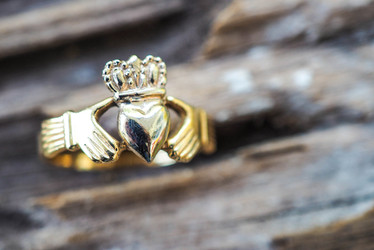A Good Luck Gift: The Origin of the Claddagh
Posted by ShamrockCraic on 15th Oct 2015
Irish heritage and culture is rich with history, tradition, and folklore. The reverence for their roots is what has created and spread a distinguishable Irish spirit. The Claddagh ring, which originated about 300 years ago, is only one example of how their present is based on their past.
The Claddagh ring, also known as a “friendship ring” or “faith ring” is an Irish birthstone or wedding ring. Its unique design features a crown atop two hands holding a birthstone heart symbolizing, “The hands are for friendship the heart is for love and the crown is for loyalty held high above.”
There are many legends revolving around the Claddagh’s origin. One story tells of Margaret Joyce, who was married to a wealthy Spanish merchant, Domingo de Rona. Upon his passing, Margaret was endowed an abundant sum of money. She later remarried the Mayor of Galway and used her inheritance to build several bridges in Connacht. Supposedly, as a reward for generosity and hard work an eagle dropped the first Claddagh in her lap.
A second tale involves a prince and a maid. According to the story, the prince fell in love with the commoner, but her father questioned his intentions. To prove his desire was true he designed the first Claddagh representing his friendship, loyalty, and love toward the maid. When the prince purposed, and the ring’s meaning was revealed, her father gave his blessing.
Finally, the most popular story of the ring’s origin features Richard Joyce, a fisherman from Claddagh. One day, Richard was kidnapped by Algerian pirates and sold to a Moorish goldsmith as his slave. Richard never forgot about his truelove back home and crafted the first Claddagh in her memory. One version of the story says that Richard escaped and returned home. The other says Richard was freed when William the III of England demanded the release of all British subjects. This version continues with the Moorish goldsmith offering a portion of his fortune, as well as, marriage to his daughter, if he remained in Algiers. Richard refused the offer, returned home, and purposed immediately to his true love when he heard she had never married. While the details of how he got captured, whether or not he was already married, and how he got away depend on the variation, the main plot of the story is consistent.
The Claddagh is not just important because of its historical significance, but also because of the significance it continues to hold today. It is one of the most popular Irish engagement or wedding rings, and continues to be a treasured heirloom. Their meaning lies beyond the symbolism of the ring itself and translates further based on how it is worn. If a woman is married or engaged, she is supposed to wear the ring on her left hand, with the crown facing away from her heart. If the ring is worn on the right hand with the crown facing away from the woman, it means she is single, but interested in finding love, and if the crown facing toward the woman it means she is not interested in love.
While the Claddagh is typically associated with deeper meanings and is a gift anyone would be lucky to receive, it has been warned that it should remain a gift, because it said to be very bad luck for a person to purchase the ring for themselves.

